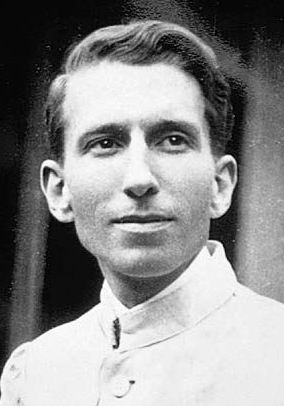Guido Gozzano facts for kids
Quick facts for kids
Guido Gozzano
|
|
|---|---|
 |
|
| Born | 19 December 1883 Turin, Italy |
| Died | 9 August 1916 (aged 32) Turin, Italy |
| Occupation | Poet, writer |
| Literary movement | Crepuscolari |
Guido Gustavo Gozzano (born December 19, 1883 – died August 9, 1916) was an Italian poet and writer. He is known for his unique style of poetry. He was part of a group of poets called the Crepuscolari.
Contents
Guido Gozzano's Life Story
Guido Gozzano was born in Turin, Italy. His father, Fausto Gozzano, was an engineer. His mother, Diodata Mautino, was the daughter of a senator. The family owned a large estate called Villa Il Meleto in Agliè. Guido spent much of his life in these two places.
Even though he was often sick, Guido enjoyed sports. He liked ice-skating, cycling, and swimming. He didn't do very well in primary school. After secondary school, he studied law at the University of Turin. However, he never finished his law degree. He preferred to attend literature classes instead.
Learning from Arturo Graf
Guido Gozzano was greatly influenced by the poet Arturo Graf. Graf taught literature at the university. Many young writers in Turin liked Graf's ideas. Graf's way of thinking was a bit sad, like the poet Giacomo Leopardi. But it also had a hopeful side, like a kind of socialism.
Graf helped Gozzano find his own voice in poetry. At first, Gozzano's writing was similar to another famous poet, Gabriele D'Annunzio. Graf encouraged Gozzano to study older poets like Dante Alighieri and Francesco Petrarca. This helped Gozzano improve his writing style.
Health Challenges and Love Letters
In May 1907, Gozzano's health got much worse. He developed a serious lung illness called pleurisy. Because of this, he had to spend the rest of his life in warmer places. He lived mostly on the Italian Riviera and in mountain towns.
Also in 1907, Gozzano started a relationship with a young poet named Amalia Guglielminetti. They first met at a cultural society. Their relationship began with an exchange of letters. These letters were later published in 1951 as Lettere. They show that Gozzano and Guglielminetti had strong feelings for each other.
First Poems and Big Success
In the same year, 1907, Gozzano published his first collection of poems. It was called La via del rifugio. These poems were written between 1904 and 1907. A publisher in Turin released the book.
In 1909, Gozzano stopped studying law completely. He decided to focus only on poetry. Two years later, in 1911, he published his most important work. This book was called I colloqui, which means "Conversations". It was published by Treves in Milan. The poems in this book were divided into three parts.
I colloqui was very popular with both critics and readers. This success led to many offers for Gozzano to write for important magazines and newspapers. These included La Stampa, La Lettura, and La Donna. The magazine La Donna was a great place for him to publish his prose and poetry.
One of the most famous poems in "I Colloqui" is "La signorina Felicita ovvero la Felicità". In this long poem, Gozzano writes about his feelings for Felicita. She is an ordinary girl, but he describes her beautifully, like a painting. In this poem, he also talks about his health, his sad view of the world, and his wish to visit faraway places. He does this in his usual clever and funny way.
Travels and Later Works
Because his health continued to get worse, Gozzano decided to travel. He hoped a different climate would help his breathing. On February 16, 1912, he left Genoa on a cruise ship. He visited places like Colombo and Bombay in India and Ceylon. He returned in May 1913. The trip didn't make him better, but it gave him ideas for new writings. These writings were published after his death in 1917. The book was called Verso la cuna del mondo ("Towards the world's cradle").
In his last years, Gozzano wrote less. In March 1914, he published parts of a long poem called Le Farfalle ("The butterflies"). He never finished this poem. Around this time, he also published a collection of six fairy tales. These stories were written for the children's magazine Corriere dei Piccoli. The book was titled I tre talismani ("The three talismans").
Guido Gozzano loved theatre and movies. He even adapted some of his short stories into scripts. Between 1914 and 1915, he wrote some poems about World War I. These poems were not very popular.
In 1916, shortly before he died, Gozzano started writing a film script. It was about Francis of Assisi, but the film was never made. Guido Gozzano passed away and was buried in Agliè.
Guido Gozzano's Works
Poetry
- La via del rifugio (1907)
- I colloqui (1911)
- Tutte le poesie (1980) - This book includes all of Gozzano's poems.
Prose
- I tre talismani (1914) - A collection of fairy tales for children.
- La principessa si sposa. Fiabe (1918) - More fairy tales.
- Verso la cuna del mondo. Lettere dall'India (1912-1913) (1917) - Letters from his travels in India.
- L'altare del passato (1918)
- L'ultima traccia (1919)
- Primavere romantiche (1924)
- La moneta seminata e altri scritti (1968)
- Verso la Cuna del mondo - Lettere dall'India (2005) - A more complete edition of his India letters.
- Requiems & Nightmares (2015)
Letters
- Lettere d'amore di Guido Gozzano e Amalia Guglielminetti (1951) - Love letters between Guido and Amalia.
- Lettere a Carlo Vallini con altri inediti (1971) - Letters to a friend.
See also
 In Spanish: Guido Gozzano para niños
In Spanish: Guido Gozzano para niños

